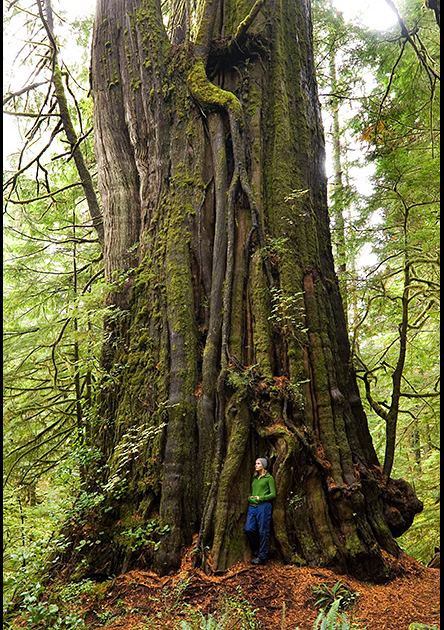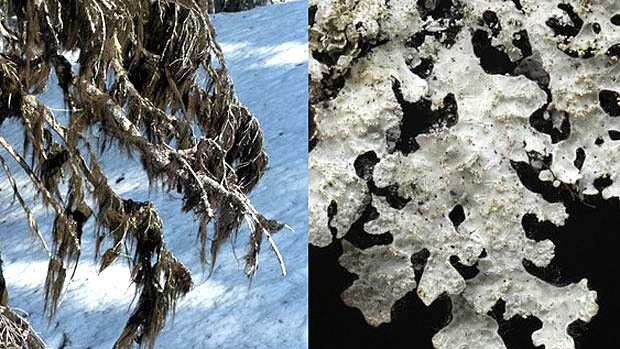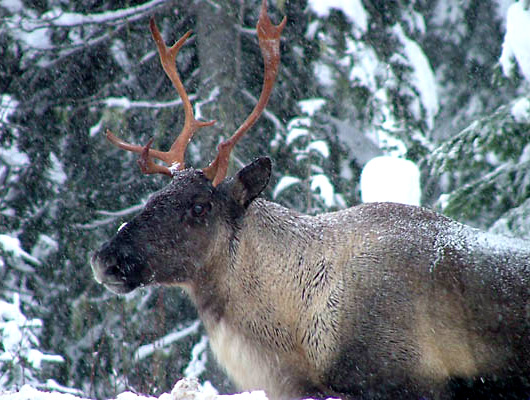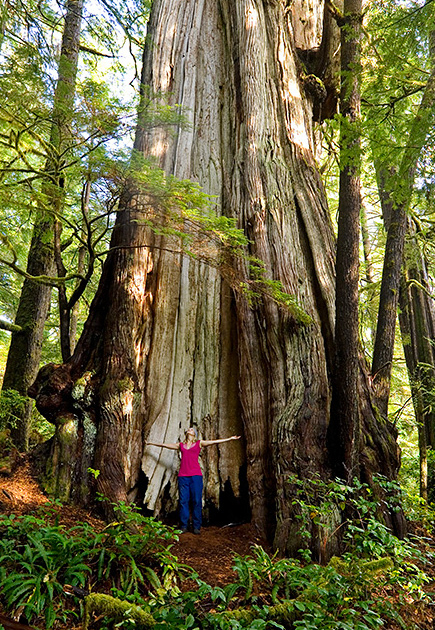Canada’s biggest tree
Canada’s largest tree, a western redcedar named the “Cheewhat Giant” stands in a remote location near Cheewhat Lake west of Lake Cowichan. The tree is over six meters (20 feet) in trunk diameter, 56 meters (182 feet) in height and 450 cubic meters in timber volume (or 450 regular telephone poles’ worth of wood). Luckily, the tree, discovered in 1988, is just within the Pacific Rim National Park Reserve, which was created in 1971.
Extensive logging of the last unprotected old-growth forests adjacent to the national park is taking place in the “West Coast Trail Wilderness” of the Klanawa, Rosander, Upper Nitinat, Upper Walbran, Gordon, Hadikin Lake and San Juan Valleys as the market for cedar rebounds.
“Pacific Rim is a very narrow, linear park just a couple kilometres wide along much of the West Coast Trail. Old-growth logging adjacent to the park is silting up salmon streams that flow into the park, diminishing the contiguous wildlife habitat and undermining the wilderness experience for hikers who hear the roar of chainsaws through the narrow buffer of trees,” states Ken Wu, Ancient Forest Alliance co-founder. “However, more importantly, the last unprotected ancient forests adjacent to the West Coast Trail unit are literally the grandest forests left in Canada. They must be protected and we need a forward thinking government to do so.”
Former Member of Parliament for the riding of Juan de Fuca, Keith Martin, proposed to include these adjacent old-growth forests within an expanded Pacific Rim National Park Reserve.
“Keith Martin had a very visionary proposal and I hope other politicians will also rise to the moral imperative to protect our ancient forests,” states TJ Watt, Ancient Forest Alliance co-founder. “Future generations will look back at the majority of BC’s politicians today who still sanction the elimination of our last endangered old-growth forests on Vancouver Island, despite the second-growth alternative for logging, and see them as lacking vision, compassion and a spine. We desperately need more politicians with courage and wisdom to step forward.”
Satellite photos show that about 75 percent of the original, productive old-growth forests on Vancouver Island have been logged, including 90 percent of the valley bottoms where the largest trees grow and most biodiversity is found.
The BC government regularly inflates the statistics on the amount of remaining coastal old-growth forests as part of its public relations spin by including vast tracts of stunted “bonsai” forests in bogs and high subalpine reaches with small trees of low or no commercial value.
“It’s like counting your fake Monopoly money with your real money and claiming to be a millionaire, so stop worrying about your runaway spending habits,” stated TJ Watt.
Despite new markets in China, BC’s coastal forest industry is still a shadow of what it once was. The coastal industry’s 20-year decline at its root has been driven by resource depletion as the largest ancient trees in the valley bottoms and lower slopes have been largely logged-off. This has resulted in diminishing returns as the remaining trees get smaller, lower in value and more expensive to reach high up mountainsides and far away in valley headwaters.
The resulting loss of tens of thousands of rural jobs has also been paralleled by the increasing collapse of BC’s old-growth ecosystems, with plummeting salmon, steelhead, black-tailed deer, cougar, mountain caribou, marbled murrelet and spotted owl populations (only five individuals left in BC’s wilds today).
“The depletion of BC’s biggest, best old-growth stands and the resulting collapse of ecosystems and rural communities has parallels throughout the history of resource extraction. We’ve seen it with countless fishing-down-the-food chain examples, such as the collapse of the Atlantic cod stocks. Why would we let this destructive history of blind greed repeat itself in BC’s forests?” asked Ken Wu. “It’s time for politicians to understand that the consequences of supporting callous resource depletion policies are not born out only in rural communities and the demise of millions of living creatures, but also in their own political careers.”
The Ancient Forest Alliance is working to raise funds for a fall campaign in provincial swing ridings calling on the BC government to protect our endangered old-growth forests, ensure sustainable second-growth forestry and end raw log exports to foreign mills.
Link to Common Ground article: https://www.commonground.ca/iss/241/cg241_biggesttree.shtml





